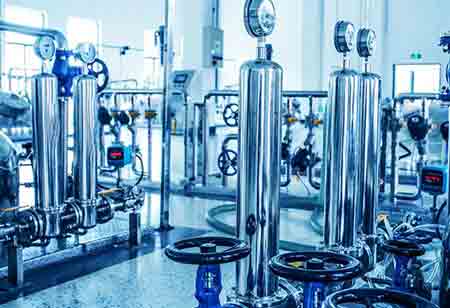Thank you for Subscribing to Chemical Industry Review Weekly Brief
Outlook on the Post-pandemic Scenarios in the Chemical Industry

Thank you for Subscribing to Chemical Industry Review Weekly Brief

By
Chemical Industry Review | Thursday, March 02, 2023
Stay ahead of the industry with exclusive feature stories on the top companies, expert insights and the latest news delivered straight to your inbox. Subscribe today.
Although the majority of these trends have been evident for some time, COVID-19 has significantly accelerated their adoption rates and increased their scope.
FREMONT, CA: Understanding everything from viral vaccinations to the creation of intelligent materials utilised by researchers depends heavily on chemistry. In the framework of the current socioeconomic situations, the perspectives shed light on many difficulties and strategies in scientific research and business to make the world's economy more developed. The fixed wireless access or fibre optic connections that will revolutionise some industries, such as home-based work, home-based learning, and home-based entertainment, will undoubtedly benefit the general public and the typical user.
The curriculum of the higher education system must take into account modern scientific and technological breakthroughs, and industry-academia partnerships are essential for providing students with real-world experience that will help them develop fresh perspectives and work on problem-solving projects. By ongoing education and upgrading of skills that become more crucial as technology develops, we can remain relevant. The Indian chemical industry anticipates a market size of 383 billion USD by 2030 and is currently the sixth largest producer and exporter of chemicals in the world.
People have been compelled to think differently as a result of the pandemic. This has led to several grassroots ideas that simplify technology for the general public, especially in rural areas. An early diagnostic tool for anaemia, diabetes, and hypertension might be a simple blood marker that measures haemoglobin levels. Using technologies and methods that can measure glucose, creatinine, and haemoglobin levels, we can evaluate the overall health of the populace, manage common illnesses, and enhance rural healthcare in the nation.
In India, where patients typically arrive at hospitals in advanced stages, the development of an electronic nose (e-Nose) device for early detection of lung cancer by volatile organic compounds (VOCs) we exhale is necessary. The use of simple devices helps avoid complex procedures used to detect such cases. Rural healthcare in a setting with limited resources can be revolutionised by the design, development, and applicability of new diagnostic tools or screening devices for other diseases or disorders like asthma, anaemia, diabetes, hypertension, tuberculosis (TB), chronic obstructive pulmonary disease (COPD), and cancer.
By working together, the federal and state governments can manage many common problems medically with a comprehensive care programme to lower major health risks by the end of this decade. This is one of the most significant components of the post-covid world. Analysing the pandemic's effects via a variety of lenses and identifying important trends in the chemicals and materials ecosystem point to the need for market participants to implement their action plans and engage in strategic supply chain management. Enablers in the journey of accelerated recovery and ensuring business continuity include the use of governmental stimulus packages, creating strategic alliances, collaboration for innovation, the use of mergers and acquisitions opportunities, and transforming to gain competitive advantage.
Based on the development of effective extraction technologies, alternative energy storage options, and the design of extremely resource-efficient goods, the recent discovery of lithium resources in Jammu and Kashmir is a welcome energy source. The pharmaceutical, petroleum, electronics, and automotive industries have the potential to develop into major centres for export production. India is on the right track, but accelerated transformation through improved business-friendliness, creative ways to attract more investment, building out communications and industrial infrastructure, implementing production-linked incentive programs, and attracting the workforce of the future by utilising demographic dividend would go a long way towards making India a five trillion dollar economy.
To achieve inclusive and sustainable growth while becoming a leading global economic powerhouse, consistent attention and action are needed. Businesses need to rethink and redefine clean and renewable energy, green initiatives (such as sustainable farming, fuel, technology, and vegetation coverage), corporate alignment with international marketing networks, supply chain management reforms, and a strong culture of innovation and entrepreneurship. The chemicals and materials sector is in the recovery phase after the covid-19 impact when the postponement of investment and consumption took place. Now, significant opportunities for growth and transformation allow it to become a thriving business as indicated by scenario analyses.
Using resources wisely and drastically minimising waste output through prevention, reduction, recycling, and reuse are vital for achieving sustainable chemical manufacturing. Yet, due to rising inflation and global macroeconomic uncertainty, the most recent trend is towards cost-cutting and vendor consolidation.
India's services industry makes a considerable contribution to its GDP (66 per cent), exports, and creation of big numbers of jobs (28 per cent), and chemicals are used in practically all of the items we consume. Construction, commercial, and trade services, hospitality, healthcare, professional services, financial and insurance services, as well as personal, social, and communication services are all included in this sector.
India is a developing market in the world due to its knowledge-based services, which have distinct abilities and competitive advantages, and the Government of India's support for digital ecosystem, clean India, citizen-centric welfare programmes, and smart city projects. A change in their service offerings is necessary to accommodate the demand impact across a variety of chemical end-markets, including agriculture (crop protection/surfactants), automotive (polymers/fuel additives), construction (pigments/solvents), consumers (dyes/polymers), energy (polysilicon/epoxy), nutrition (vitamins/amino acids), pharmaceuticals (pharma excipients/active ingredients), hygiene (emollients/toothpaste), and packaging (plastic/paper). The service offerings offered by the chemical industry are extensive and include product-based, value-added, process improvement, and outcome-based services.
I agree We use cookies on this website to enhance your user experience. By clicking any link on this page you are giving your consent for us to set cookies. More info



